mobile Ansicht, to the English Version tap the flag
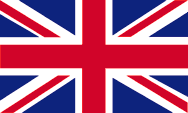

- Demokratische Bundesrepublik Nepal
- 1768–2007 Königreich
- Eigenbezeichnung: Sanghīya Loktāntrik Ganatantra Nepāl
• Flagge
• historische Flaggen
• Bedeutung/Ursprung der Flagge
• Wappen
• historische Wappen
• Bedeutung/Ursprung des Wappens
• Flugzeugkokarde
• Landkarte
• Zahlen und Fakten
• Geschichte
• Ursprung des Landesnamens

Nationalflagge,
Quelle, nach: Wikipedia (EN),
Drawn by User:Pumbaa80, User:Achim1999,
Public domain, via Wikimedia Commons







1930—1962,
Nationalflagge,
Quelle, nach: Wikipedia (EN),
Orange Tuesday, CC BY-SA 3.0,
via Wikimedia Commons




1856—1930,
Nationalflagge,
Quelle, nach: Wikipedia (EN)



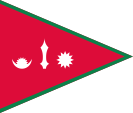
18./19. Jhd./cent.,
Truppenfahne,
Quelle, nach:
Wikipedia (EN)




1969,
Standarte des Königs,
Seitenverhältnis = 11:8,
Quelle, nach: Wikipedia (EN),
Sodacan, CC BY-SA 4.0,
via Wikimedia Commons



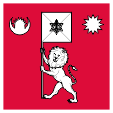
2001,
Standarte des Königs,
Seitenverhältnis = 1:1,
Quelle, nach: Wikipedia (EN),
Sodacan, CC BY-SA 4.0,
via Wikimedia Commons




Die heutige Flagge Nepals wurde am 16.12.1962 – im Zusammenhang mit dem Inkrafttreten der neuen Verfassung – eingeführt, nach anderen Quellen jedoch schon am 16.12.1961. Sie ist die einzige nicht rechtwinklige Nationalflagge der Welt, ist oben abgeschrägt und am fliegenden Ende mit einem Einschnitt versehen. Sie zeigt übereinander eine weiße Sonne und einen weißen Mond auf dunkelblau eingerahmtem karminroten Grund. Ihre Wurzeln liegen im 19. Jahrhundert. Die Farben der Flagge scheinen heute folgendermaßen definiert zu sein, und zwar: Blau = HEX #003594, was Pantone 287 entsprechen würde, Rot = HEX #DD0C39, was Pantone 192 entsprechen würde. Über Ursprung und Bedeutung der Flagge sowie der Farben gibt es die unterschiedlichsten Theorien:
• Die Form der Flagge als Doppelwimpel geht auf frühe persische Einflüsse zurück.
• Die Flagge ist – im Gegensatz zu früher – kein Doppelwimpel mehr, sondern vereinigt zwei grundsätzlich verschiedene Wimpel.
• Sonne und Mond erinnern an den ewigen "Kreislauf der Zeit".
• Sonne und Mond verkörpern die Hoffnung, die Nation möge so lange Bestand haben wie diese Himmelskörper.
• Sonne und Mond verkörpern zwei rivalisierende Zweige der Familie Rana, die Bahadur und die Schamscher.
• Sonne und Mond verkörpern die historischen und lokal bedeutsamen Familien des Premierministers (Familie Rana = Sonne) und des Königs (Familie Bir Bikram = Mond).
• Die beiden Dreiecke symbolisieren die beiden Religionen des Landes, den Hinduismus und den Buddhismus, die Sägezahnform soll an die Gipfel des Himalaya erinnern.
• Eine weiße Sonne auf rotem Tuch mit blauem Rand war die Flagge des Teilkönigreiches Mastang (auch Königreich Lo, seine Existenz endete 2008), so dass die zweiteilige Flagge als Kombination der Symbolik des Gurkha-Staats und von Mastang interpretiert werden könnte.
• Karminrot ist die Nationalfarbe von Nepal, offiziell "Karmesinrot" genannt. Es ist die Farbe der hier wachsenden Rhododendren.
• Rot und Blau sind die Nationalfarben von Nepal.
Vor 1962 zeigten die Abbildungen von Mond und Sonne in der Flagge Gesichter mit Kastenmalen. Die Flagge des Königs war einfarbig rot mit einem silbernen steigenden Löwen in der Mitte, der eine silberne Flagge hält. In den oberen Ecken, in Silber, Mond und Sonne. Dies könnte ein Widerspruch dazu sein, dass Sonne und Mond Symbole von Familien sind, denn weshalb sollten beide zusammen auf dem Banner des Königs auftauchen?
Quelle: Flags of the World, Wikipedia (DE), Wikipedia (EN), Volker Preuß

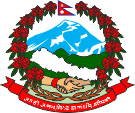
seit 2007,
Wappen von Nepal,
Quelle, nach:
Wikipedia (EN),
CAPTAIN MEDUSA, CC BY-SA 4.0,
via Wikimedia Commons


1962–2006,
Wappen von Nepal,
Quelle, nach:
Wikipedia (EN)
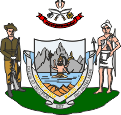
1946–1962,
Wappen von Nepal,
Quelle, nach:
Wikipedia (EN)
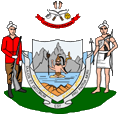
1935–1946,
Wappen von Nepal,
Quelle, nach:
Wikipedia (EN)

Das heutige Staatswappen wurde am 18.05.2008 angenommen und 2020 in Details abgeändert. Es zeigt innerhalb eines Kranzes von Rhododendronblüten (Nationalblume) eine stilisierte weiße Landkarte Nepals vor der Silhouette des Mount Everest und einer Himalaya-Berglandschaft. Darunter ein Handschlag von Mann und Frau. Unten ein rotes Spruchband mit der weißen Sanskrit-Aufschrift "Janani Janmabhumisca svargadapi Gariyasi" → "Das Heimatland ist teurer als das Himmelreich". Dieses Wappen zeigt im Vergleich zu seinem Vorgänger keine Königskrone mehr. Ein Zeichen für die durch die neue Verfassung abgeschaffte Macht des Königs. Das zwischen 1962 und 2007 gültige Staatswappen zeigte als Hauptbestandteil eine nepalesische Landschaft mit den Himalajabergen im Hintergrund, einer weißen Kuh, einem Fasan und Rhododendronblüten. Unten war ein rotes Spruchband mit der Sanskrit-Aufschrift "Das Heimatland ist teurer als das Himmelreich". Links und rechts als Schildhalter standen je ein Gurkhasoldat in moderner und historischer Uniform. Oben zwei Khukuri-Dolche, zwei nepalesische Flaggen, die Fußspuren Gorakhnaths (des Gottes der Gurkhas), und die Königskrone als Symbol der damals wiedererrichteten absoluten Monarchie. Bis zum 16.12.1962 verwendete Nepal ein Wappen, in dessen Schild der Hindugott Shiva zu sehen war, der vor den Bergen des Himalaya aus dem Meer aufsteigt. Oberhalb des Schildes zwei Khukuri-Dolche, Mond und Sonne und die Fußspuren Gorakhnaths, des Gottes der Gurkha, sowie ein rotes Spruchband. Um das Wappenschild befanden sich zwei weiße Spruchbänder. In dem inneren das Staatsmotto in goldenen Sanskrit-Buchstaben "Janani Janmabhumisca svargadapi Gariyasi" → "Das Heimatland ist teurer als das Himmelreich". Das äußere Spruchband zeigte in schwarzen Buchstaben ein weiteres Motto, und zwar in Latein: "DULCIS ET DECORUM EST PRO PATRIA MORI" → "Es ist süß und ehrenvoll für das Vaterland zu sterben", eine Hommage an die berühmten Gurkha-Truppen, die in der britischen Armee dienten und bis heute dienen. Schildhalter waren zwei Gurkha-Soldaten in Britischer und traditioneller Uniform.
Quelle:
Flags of the World, Wikipedia (DE), Flaggen Wappen Hymnen, Volker Preuß

 (?)
(?)
Flugzeugkokarde,
Quelle, nach: Flags of the World

Lage:

Quelle/Source: CIA World Factbook
Landkarte des Landes:

Quelle/Source: CIA World Factbook

Fläche: 147.516 km²
Einwohner: 29.200.000 (2021), davon 25% Gurkhas und Tibeter, 28% Inder (Chhetri, Bahun)
Religionen: 81% Hindus, 9% Buddhisten, 4% Moslems, 3% Animisten, 1% Christen
Bevölkerungsdichte: 198 Ew./km²
Hauptstadt: Katmandu (auch: Kantipur oder Yambu), 985.000 Ew. (2020)
Amtssprache: Nepalesisch
sonstige Sprachen: Maithili, Bhojpuri, Tharu, Tamang, Newari, Tibetische Dialekte
Währung: 1 Nepalesische Rupie (NPR, NRs) = 100 Paisa, 1 Indische Rupie (INR, iR) = 100 Paise
Zeitzone: MEZ + 4:45 h
Quelle:
Wikipedia (DE)

Antike · Besiedlung durch tibetische Stämme
ca. 250 · der Stamm der Mewari gründet um Katmandu das Fürstentum Malla
ca. 650 · das Fürstentum Malla wird vom tibetischen Turfanreich abhängig
ca. 1150 · Malla wird wieder unabhängig
1386–1429 · Einführung des Kastensystems, in den Folgejahren zerfällt das
Fürstentum Malla in kleinere Staaten
ca. 1730 · das Volk der Gurkha beginnt die Region zu erobern, Herausbildung
eines Gurkha-Fürstentums
1756 · die keineren tibetischen Fürstentümer werden unter dem Gurkha-Fürsten
Narayan vereinigt, als Landesname setzt sich Nepal durch
1767 · militärischer Eroberungsversuch der
Britischen Ostindienkompanie
1787 · Nepal erreicht seine größte Ausdehnung, von
Kaschmir bis nach Sikkim
1793 · Handelsabkommen mit Großbritannien
1793 · Nepal muss die Oberhoheit Chinas anerkennen, Tributzahlungen an
China bis 1908
1801 · Nepal schließt einen Schutzvertrag mit Großbritannien
1814 · China verstärkt seinen Einfluss in Nepal, die Britische Ostindienkompanie lässt das Land daraufhin militärisch besetzen
02.12.1815 · Friedensvertrag von Segauli, Nepal muss Teile des Landes an Britisch-Indien abtreten und die britische Oberhoheit anerkennen
1846 · die Familie Rana putscht sich in das Amt des Premierministers und macht es dynastisch erblich, das Königtum der Familie Bir Bikram wird politisch unbedeutend
1854 · militärische Auseinandersetzungen mit Tibet
1856 · Nepal erhält Handelsprivilegien in Tibet
1920 · erste Forderungen zum Sturz der Familie Rana nach Einführung der konstitutionellen Monarchie
1947 · Gründung des Nepalesischen Nationalkongresses
1950 · König Tribhuvan (Tribhavana Bir Bikram Dschung Bahadur, 1911–1955) lässt in Indien eine Befreiungsarmee des Nepalesischen Nationalkongresses aufstellen die in Nepal einmarschiert und die Familie Rana stürzt
Januar 1951 · Einführung der konstitutionellen Monarchie nach indischem Vorbild, die Familie Rana stellt in der Regierung den Ministerpräsident
November 1951 · König Tribhuvan löst die bisherige Regierung auf, und bestellt ein Kabinett des Nepalesischen Nationalkongresses
1955 · Tod von König Tribhuvan, Nachfolger wird sein Sohn Mahendra
1959 · erste demokratische Wahlen, Sieg des Nepalesischen Nationalkongresses
1960 · König Mahendra löst das Parlament auf und verbietet die Parteien, die Verfassung wird aufgehoben und einseitige Bindung an Indien beendet
1962 · Einführung einer neuen Verfassung nach pakistanischem Vorbild mit dem sogenannten Dorfräte-System (Panchayat-System: keine Parteien, überwiegend indirekte Wahlen)
1972 · Tod von König Mahendra, Nachfolger wird sein Sohn Birendra
1979 · innere Unruhen gegen das Panchayat-System
1980 · König Birendra lässt eine Volksabstimmung über Panchayat-System durchführen, die einer Mehrheit dafür ergab
1989 · Indien verhängt eine politisch motivierte Handelsblockade gegen Nepal
1990 · blutige Unruhen durch sogenannte Demokratie- und Menschenrechtsbewegungen, König Birendra führt eine neue Verfassung ein, welche die konstitutionelle Monarchie wiederherstellt und das Panchayat-System durch ein Mehrparteiensystem ersetzt
01.06.2001 · König Birendra, Königin Aishwarya und sieben weitere Mitglieder der königlichen Familie sterben im Königspalast in Katmandu von der Hand des Kronprinzen Dipendra, der Selbstmord begeht
04.06.2001 · Birendras jüngerer Bruder Gyanendra wird zum neuen König proklamiert
2002 · Auflösung des Parlaments durch den König
2006 · Generalstreik, infolge dessen Wiedereinsetzung des Parlaments, das Parlament entzieht dem König die Exekutivgewalt, er nimmt nur noch repräsentative Aufgaben wahr
28.12.2007 · das Parlament beschließt die Abschaffung der Monarchie
28.05.2008 · Abschaffung der Monarchie, Proklamation der Republik
Quelle:
Atlas zur Geschichte,
World Statesmen,
Weltgeschichte,
Discovery '97,
Wikipedia (D)

Der Name "Nepal" geht auf die Sanskrit-Worte "nipat → hinabfliegen" und "alaya → Wohnstätte" zurück. Gemeint sind also die an den Berghängen des Himalaya klebenden Dörfer.
Quelle:
Handbuch der geographischen Namen


![]()

















 (?)
(?)

